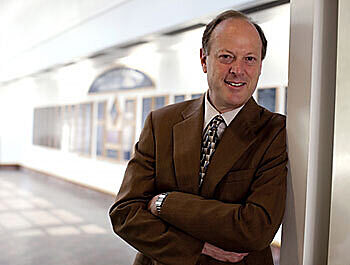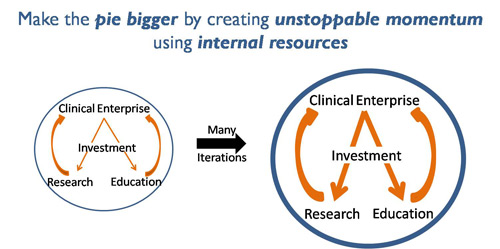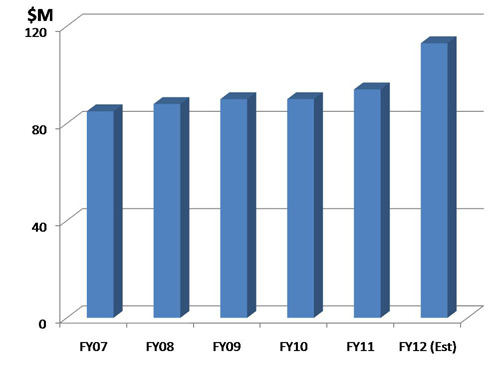Part 2 - Second Anniversary of the Strategic Plan for UF&Shands: Maintaining Momentum in a Changing Environment — Academic Adaptations

In the last issue of On the Same Page, I argued that the core principles of our academic health center are enduring and should remain as our guide, but that we must adapt our strategies to address the realities of a changing environment. The deficits in federal and state budgets, combined with an evolving legislative mood that frowns upon the public funding of education, research and health care, leads to the conclusion that we must focus on internally generated resources and philanthropy to achieve our goals.
This is not a new message; it’s just that the situation has progressed more rapidly than anticipated. The need to become more self-sufficient was emphasized as a key theme in the strategic planning process. For example, here is an image that I used to describe the overall vision of the Strategic Plan when it was launched in May 2010:

We have, indeed, created a bigger pie — benefiting all missions in the process — by leveraging internally generated resources. During a time of declining state funding for education and safety-net patient care, and of cuts in federal health care programs and NIH budgets, our clinical revenues, external research grants and philanthropy have all moved strongly in a positive direction. Quantitatively, the clinical enterprise is the most important strategic driver, as shown in the above figure. Traditionally, the three missions of an academic health center are often spoken of as a “three-legged stool,” with the leg of each mission of the same height to create balance and stability. The figure suggests a different reality, however, in which the clinical mission must be successful, first and foremost, to drive research and education.
Put differently, education sits on its own bottom financially, being funded by state allocations and tuition (both of which the Florida counts as governmental dollars in its “state general revenue” funding for the Health Science Center). The education of our students benefits greatly from faculty members who conduct great research and deliver top-quality patient care; conversely, the best faculty are drawn to an environment with the most talented students. But educational revenues do not and should not fund science and patient care. A similar picture is seen for research, which never pays for itself. A well-funded laboratory on average covers 75% to 80% of its direct expenses. The remainder must come from other sources, including endowment (philanthropy) and transfers from the clinical enterprise.
In the last issue of OTSP, I discussed the adaptations we are planning in the clinical missions. Let’s now consider the adaptations that will be necessary in our education and research missions.
Adaptations in Education
The state of Florida has been very generous to UF and its Health Science Center, providing spectacular research facilities for which we have virtually no debt, a substantial budget for the operation and management of these facilities, and baseline operating budgets for academic programs of the six HSC colleges. These operating budgets mainly support the faculty and staff who provide the educational programs in our six colleges. A fraction of these budgets is set aside for research infrastructure, so that faculty can generate data to compete for external scientific funding.
This past year, the Florida Legislature reduced the operating budgets of the State University System by $300 million. Of this amount, the reduction to the University of Florida was $38 million. During the past five years, the state’s annual budget to UF has declined by about $250 million, only about half of which has been recovered by tuition. The upcoming budget year for most of the colleges in the Health Science Center colleges will entail a 5% reduction, but because of the way the Legislature constructed their budgets, the colleges of Medicine and Veterinary Medicine were hit particularly hard, with reductions of 11% and 14%, respectively. We believe that a cut of this magnitude in the state education budget for these colleges was not completely intended nor understood by legislators, and we will be reviewing the situation with them in an effort to restore this funding. We cannot depend on a positive outcome, however, so we must plan as though these reductions are here to stay.
In contrast to the views that some have expressed in the media, there are no reserves in the state academic budget lines for any of the HSC colleges. Each year, all of the dollars in these state budgets have been used to support the colleges’ academic programs. While some of the cuts in the state education budget next year can be absorbed by attrition (i.e., not hiring faculty and staff who are retiring or leaving the university for other reasons), the HSC colleges are already quite lean because of the previous budget cuts. The principal adaptation for education long term will lie in obtaining resources from non-state sources, predominantly “off-book” tuition from Master’s programs (e.g., PHHP), out-of-state students (e.g., Veterinary Medicine) or online education (e.g., Pharmacy), and from shifting faculty effort from state-funded education activities to clinical and/or externally funded research activities. Some of these strategies employed by some colleges will likely be used by other colleges in the future. In some colleges, the amount of budget reduction cannot be managed all at once, and there will have to be a phased approach. Rest assured that the deans are working with department chairs and faculty to minimize the impact of these state budget cuts. Preserving the high quality of our educational programs is the major priority in this process.
Academic Adaptations: Research
Finally, we must consider our plans for research, which more than any other mission brings national distinction to our university and Health Science Center. Over the past several years, we have made substantial gains in research by focusing on the recruitment and retention of superb investigators and providing them with a scientific environment in which they have thrived. At a time when the NIH budget nationally is flat at best, and study-section pay-lines are mercilessly tight, we are making bold strides in NIH grant funding.
Total NIH awards to faculty members in the Health Science Center, exclusive of one-time “stimulus” grants during 2009 and 2010, shows a steady increase in funding. The jump in FY12 is in part due to one large grant — the “LIFE” study (Lifestyle Interventions and Independence for Elders) of Dr. Marco Pahor, a large clinical trial of the health benefits of exercise for the elderly.

There is significant concern in the scientific community that across-the-board cuts in the federal budget, which might occur in the next legislative session, will dramatically impact congressional funding of the NIH. This would have dire consequences for the extramural NIH program on which UF biomedical scientists depend. We will see how this plays out; meanwhile, each college is developing its own plans to support its research efforts. The College of Veterinary Medicine will use funds from its off-book tuition program; the College of Pharmacy will use funds from its off-book distance learning program; the College of Nursing will fill research positions with endowed chairs; the College of Public Health and Health Professions and the College of Dentistry will use indirect-cost-recovery funds and prior university agreements to meet existing commitments to investigators and expand in critical-path areas. And the College of Medicine will use the same methods, as well as incremental hospital funds generated by its faculty, to support investigators who are actively working on funded research. In all the colleges, centers and institutes, philanthropy will be increasingly important to support research.
So how do we maintain our momentum in a changing environment? First and foremost, we must adhere to the key principles described in the Strategic Plan. Certainly, we need to make our case as strongly as possible that the state’s citizens will benefit by restoring reductions in safety-net clinical funding and in academic budgets. But across time we must increasingly generate streams of income that are not dependent on state funding. These include clinical revenues, philanthropy, external grant funding and off-book tuition revenue.
It is said that there is no education like adversity. Along these lines, the following quote by author Ralph Blum is instructive: “Nothing is predestined: the obstacles of your past can become the gateways that lead to new beginnings.”
Forward Together,
David S. Guzick, M.D., Ph.D. Senior Vice President, Health Affairs President, UF&Shands Health System
About the author
